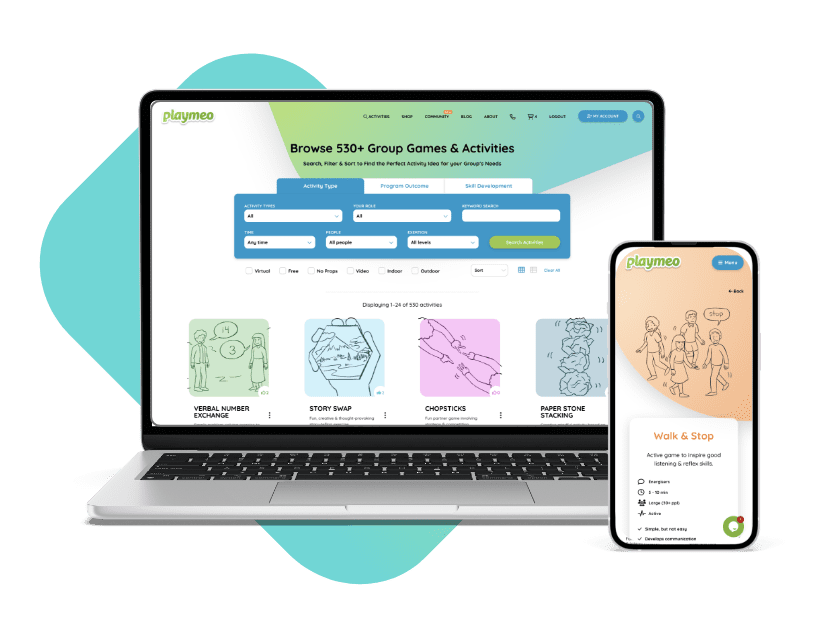Picking The Right Activity at the Right Time
This week’s Facilitator Tips episode explores the art and science of picking the right activity at the right time to help your group achieve whatever it’s trying to get done.
<< Go to Episode 38 Go to Episode 40 >>
Picking the right activity is not as simple as repeating what has worked in the past or working off your agenda. There are many attributes and nuances that can and will influence the success or otherwise of your program.
This video tutorial shares a simple, yet very powerful model that will help you make good decisions, more often.
Click the play button above to learn more about the seven key modalities of this program decision-making model.
Want to join the conversation?
Please leave a comment at the bottom of the page (you must be logged in.)
Don’t have a playmeo account? Join today.
Useful Links & Resources
- GRABBSS – click here to learn more about this multi-dimensional framework that will help you identify the seven key attributes about your group’s experience that will positively influence your programming decisions.
…EE
Video Transcript
Hi there and welcome to Episode 39 of the Facilitator Tips video series.
My name is Mark Collard, I’m an experiential trainer and an author, and today I’m really excited to share with you how to pick the right activity. That’s often a question people ask. It’s like… they’ll say, Mark, how did you know to do this after that or to design it a particular way.
Look, there’s no doubt there are elements of intuition, but actually when you explore tuition it’s just unexplored process. And one of the most powerful processes or models that I have adopted that has helped me make good decisions about the activities I use no matter how big a repertoire you might be calling on is referred to as the GRABBSS model.
It’s an acronym. It was developed by the work of Project Adventure many many years ago and adopted by many groups.
Really quickly, and there’s more details I’ll put in the show notes to find out more information about this.
But the G stands for the Goal. What are you trying to get done? What is your goal? That should lead you, instruct you to making good decisions about the activity you’re about to do.
R is for readiness. Is the group ready? That should again instruct you. If they’re not ready even though the program might say do this next, then maybe if they’re not ready you need to do something different. That’ll help you choose the right activity.
The A is probably the most difficult to understand. It’s the Affect. You know that gut feeling? You know, you walk into a room and you feel like you could cut the air with a knife? That’s your gut talking to you. So what are the sensations of the group? Connect with the group. Are they feeling happy? Are they despondent? All of those sorts of emotions will help guide you towards where you want them. If they’re having too much fun and they need to be serious, that’ll help you pick the right activity and vice versa.
The two Bs, Bodies and Behaviours. You know, if you’ve been outside and it’s cold don’t stand around processing that activity, move inside. Warm them up. But it might also be maybe they have disabilities or there’s a lack of focus or concentration. Those will be elements that will help you make better decisions about how you pitch the activities.
And the behaviours, everything from boredom to aggression, violence, apathy, again you need to connect with your group, look and observe what’s going on, get a sense for what’s happening, and those behaviours will help you pick the right activity.
The last two Ss, the S for one of them stands for the Stage of the group’s development. There’s a lot of work in this space about what stages groups go through in the development of their life. Tuckman, Bruce Tuckman’s model, you’d be familiar with it, the forming storming norming performing, and depending on which text you read the transforming or mourning stages. Again, more notes in the show notes for you to get more information about that.
But that can be a really wonderful way to look at the elements of the stages of the group development. If they’re in the early days maybe you need to pitch the challenge a lot simpler than a group that’s in the performing stage where they can actually work with something that’s more challenging. It helps you make the right activity.
And finally, the final S is Setting. Setting is not just about the environment physically, but it’s also the mental and emotional setting as well, the cultural background. Are they going to be viewed? I guarantee you, a group that is being witnessed by other people are going to behave really differently. And again will make a big difference to the way that you choose the right activities.
I’ve only spent a couple of minutes describing this model to you. There is so much more information, and you can certainly read it in some of my books, but go to the show notes at www.playmeo.com Episode 39. Please leave a comment.
What are some of the factors that you’re using to help you make good decisions about the activities that you use?
So thanks again for watching. I really appreciate it. There are many other episodes. If you’re new to us, feel free to leave a comment, feel free to share, and otherwise, I look forward to seeing you at the next episode.
Bye for now.







There are currently no comments